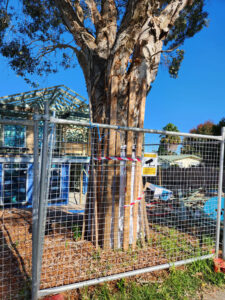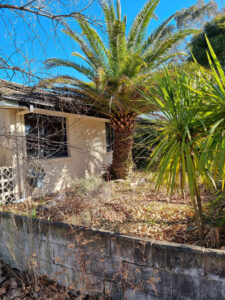
Garden trees – the choices we make
By Patrick Regnault
There is a big emphasis on planting trees in gardens, parks and streets to help cool down our towns and cities, and to reduce the need for air conditioning. Whilst trees bring great benefits, we also need to be smart and mostly practical about which trees to use, where to plant them and how to look after them.
In some cases trees may not be the solution and large shrubs may be more effective. In NSW, planning conditions define trees as ‘a long-lived woody perennial plant greater than (or usually greater than) 3m in height, with one or relatively few main stems or trunks’. According to the Australian Botanic Gardens, a tree is defined as a woody plant more than 5m tall, usually with a single stem. A shrub is a woody plant less than 8m tall, frequently with many stems arising at or near the base. As we can see, a tree is defined differently depending on the circumstances.

With shrinking gardens we need to reflect on more suitable plant choices to create the desired effect and the long-term health of the vegetation. For this article I chose to collect reflections from colleagues from different parts of the country and interestingly, a few themes came through regularly. Proper use of plants, horticultural knowledge and local planning regulations.
The first two are clearly related – the decline in horticultural knowledge leads directly to improper use of plants. But this is not the only reason, misuse of plants can also be due to greed, neglect of known information to fit into trends or short-term satisfaction, and a disregard for the fact that plants are living organisms and not mere vanity objects.

To remedy this we need to improve horticultural education, not only to the general public but also to students and practitioners. A licence to practice horticulture may be a start, with CPD (continuing professional development) points required to keep the licence active perhaps? A tree placed in the wrong spot can cause serious structural damage to infrastructure and buildings. There are limits for liability for structural defect but remember there is none for design failure.

For Nick Sanderson, an arborist working in Northern NSW, the issue he encounters too frequently is species selection and lack of appropriate advice given at the time of purchase at the nursery or by the landscaper. According to Nick: “Species selection is critical for long term management of trees planted in the urban environment. There are plenty of beautiful low-risk trees that can be used in our landscape. Understanding their growth habit and the time it takes for their full development is crucial for long term success. We also need to understand what climatic environment we are working in, where these plants are from and what makes them thrive. Planting a tree outside of its climatic zone can have a dramatic effect on its growth, in either direction. Understanding local factors such as the soil type, temperature range, rain, wind, and sunlight, all play their part in how a tree will respond so should be considered. We shouldn’t be holding back on planting trees in our urban environment. Our wildlife requires it of us. We just need to either gain the knowledge or pass that understanding on to the people that will live with the selection, hopefully for many years to come.”
Planning regulations regarding tree canopy varies a lot from state to state, and even shire to shire. Some have a 1:1, 4:1, to 10:1 replacement ratio. Trees can be planted on-site, or off-site by giving the council a fee to replant the trees somewhere else. The longevity and health of the replacement trees are not monitored, making these regulations more of a lip service to the environment than real substantive tree canopy preservation or regeneration.
Existing tree care during construction is often either ignored or misunderstood. We can see some perfunctory effort made to limit damage to trunks but the protection to the root zone is ignored by the builder, owner and council officers alike. Lack of training, lack of qualified input, or reckless negligence? Take your pick.
As a profession, we need to have a campaign of information on trees in gardens. Not a feel-good smiley job but proper informed communication with the building industry associations, developers, horticultural educators and governing authorities.
Patrick Regnault FAIH RH0062
Interactive Landscapes
E: patrickregnault@hotmail.com
Main image: A well-protected paperbark tree (Image: Janet Hodgkiss)
